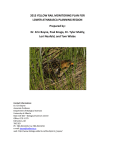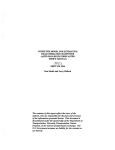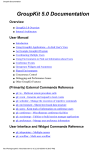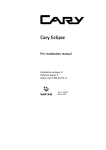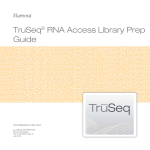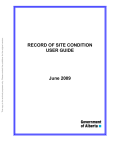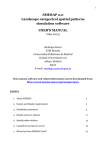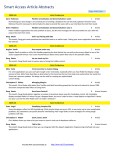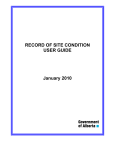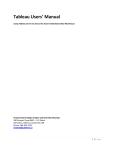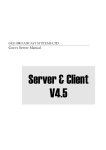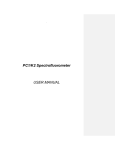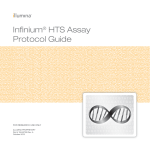Download OSCIEF-Manual-2010 - University of Alberta
Transcript
Oil Sands and Coal Interfacial Engineering Facility (OSCIEF) - Draft Mission Statement The Oil Sands and Coal Interfacial Engineering Facility (OSCIEF) is a multidisciplinary facility dedicated to the scientific exploration of interfacial phenomena associated with non-renewable resources and water. OSCIEF Policies and Procedures – Glen Thomas User Manual - 2010 Page 1 Draft Copy – Subject to Change Without Notice (see web site for latest update) Oil Sands and Coal Interfacial Engineering Facility (OSCIEF) - Draft Safety OSCIEF is committed to providing a safe work environment for all users. Users are expected to cooperate with all facility safety initiatives and to notify facility staff of any perceived hazards. OSCIEF Policies and Procedures – Glen Thomas User Manual - 2010 Page 2 Draft Copy – Subject to Change Without Notice (see web site for latest update) Oil Sands and Coal Interfacial Engineering Facility (OSCIEF) - Draft TABLE OF CONTENTS 1 Location and Contact .................................................................................................. 4 2 Description of Facility ................................................................................................ 4 3 Facility Personnel........................................................................................................ 5 3.1 Management........................................................................................................ 5 3.1.1 Director ....................................................................................................... 5 3.1.2 Research Advisory Council (RAC) ............................................................ 5 3.1.3 Steering Committee .................................................................................... 6 3.1.4 Project Manager .......................................................................................... 6 3.2 Technicians ......................................................................................................... 6 4 Definition of Facility Users and Rates........................................................................ 6 4.1 Principal Users .................................................................................................... 7 4.2 Academic Users .................................................................................................. 7 4.3 Contributing Partners .......................................................................................... 7 4.4 Non-Academic (External) Users......................................................................... 7 5 Safety .......................................................................................................................... 7 5.1 Emergency Response .......................................................................................... 7 5.2 Incident Reporting .............................................................................................. 8 5.3 Chemical Safety .................................................................................................. 8 5.3.1 WHMIS Training (Facility Access)............................................................ 8 5.3.2 Use of Chemicals ........................................................................................ 9 5.3.3 Protective Clothing/Equipment................................................................... 9 5.3.4 Storage of Chemicals ................................................................................ 10 5.3.5 Disposal of Chemicals .............................................................................. 10 5.3.6 Cleanliness (Housekeeping)...................................................................... 11 5.3.7 MSDS (and Other Info) ............................................................................ 11 5.3.8 Working Alone Protocol ........................................................................... 12 5.3.9 Unattended Operations.............................................................................. 12 5.3.10 Emergency Equipment.............................................................................. 12 5.4 Flammables ....................................................................................................... 12 5.5 Cryogenic Liquids............................................................................................. 12 5.6 Laser Safety ...................................................................................................... 13 5.7 Incidents and Safety Concerns.......................................................................... 13 6 Training..................................................................................................................... 13 6.1 Computer Training............................................................................................ 13 6.2 Instrument Training .......................................................................................... 13 7 General Laboratory Behaviour ................................................................................. 14 7.1 Cleanliness ........................................................................................................ 14 7.2 Scheduled Events (Booking Instruments)......................................................... 14 8 Discipline .................................................................................................................. 14 8.1 Enforcement...................................................................................................... 14 9 Fees and Booking...................................................................................................... 15 10 Intellectual Property and Data .............................................................................. 15 11 Sample Submissions ............................................................................................. 16 12 Facility Website .................................................................................................... 16 OSCIEF Policies and Procedures – Glen Thomas User Manual - 2010 Page 3 Draft Copy – Subject to Change Without Notice (see web site for latest update) Oil Sands and Coal Interfacial Engineering Facility (OSCIEF) - Draft 1 Location and Contact The Oil Sands and Coal Interfacial Engineering Facility, hereafter referred to as “the Facility”, is located in the National Institute for Nanotechnology (NINT) building on the campus of the University of Alberta in Edmonton, Alberta, Canada. Our web site can be found at www.oilsands.ualberta.ca/oscief. The main contacts for academic and industrial users of the Facility are the Facility Technician (492-8807) and the Project Manager/Engineer, Glen Thomas (492-0016). The Technician is responsible for day-to-day operational issues while the Project Manager is responsible for the general operation of the Facility. Specific operational questions can be made to the Technician and general inquiries can be made to the Project Manager. The Technician will give new users their initial orientation to the Facility as well as set up the scheduling of equipment. Specific problems with equipment should be addressed to facility technicians. For inquiries about the computing network please phone our systems analyst, Jonathan Clark, at 492-7368. Technical questions about the remainder of the facility equipment can be addressed to our facility technician at 492-8807 or 492-8781. 2 Description of Facility The Facility is housed within 3 laboratories (i.e., 5-028, 5-071, and 5-077) that contain the following equipment: 1. Surface Laboratory (5-028) a. Confocal Microscope with Optical Tweezers b. Brewster Angle Microscope – BAM c. Interfacial Shear Rheometer d. Langumuir Troughs e. White Light Scanning Confocal System f. Surface Force Apparatus g. Ellipsometer 2. Light Scattering Laboratory (5-071) a. UV-VIS Spectrometer b. Spectrofluorometer c. Dynamic/Static Light Scattering Instrument d. FTIR Microscope/PEM/Spectrometer e. Motorized Inverted Microscope with Imaging System 3. Flow Laboratory (5-077) a. Acoustic and Electroacoustic Particle Size and Zeta Potential Analyzer b. Micro Particle Image Velocimeter (PIV) with Laser Induced Fluorescence (LIF) c. Mirco Gas Chromatograph 4. Advanced Symbolic Computational Cluster This equipment is shared by the group and is at the disposal of the Facility. OSCIEF Policies and Procedures – Glen Thomas User Manual - 2010 Page 4 Draft Copy – Subject to Change Without Notice (see web site for latest update) Oil Sands and Coal Interfacial Engineering Facility (OSCIEF) - Draft The Facility also has the following software available on its computing cluster: Gromacs NAMD VMD Open MPI Fortran, C++, and C Compilers COMSOL CanvasX Autodesk Any additions to the above list of software must be approved by the Director. The current list of available software can be found on our web site. 3 Facility Personnel 3.1 Management The management of the Facility consists of the following: Director Steering Committee Research Advisory Council Project Manager Facility Technicians. 3.1.1 Director The Director is responsible for the Facility. The Director works in conjunction with the Research Advisory Council to determine the general direction of the Facility and, at the same time, works with the Steering Committee to insure that day-to-day operations run smoothly. The Director of the Facility is Subir Bhattacharjee. 3.1.2 Research Advisory Council (RAC) The Research Advisory Council (RAC) establishes the policies for the Facility. These policies affect the manner in which the Facility is run including: the operation and maintenance of equipment, access to instruments, equipment upgrades, training protocols. In addition, the RAC establishes the organizational structure of the Facility and the user fee schedule. Also performs financial planning and budgeting. The current Council consists of the following members: Subir Bhattacharjee (Chair), Alidad Amirfazli, Andrzej Czarnecki, Murray Gray, and Zhenghe Xu,. OSCIEF Policies and Procedures – Glen Thomas User Manual - 2010 Page 5 Draft Copy – Subject to Change Without Notice (see web site for latest update) Oil Sands and Coal Interfacial Engineering Facility (OSCIEF) - Draft 3.1.3 Steering Committee The Steering Committee is responsible for executing the objectives delineated by the RAC and insuring that the all the operational and governance protocols are fully established. The RAC will be responsible for the management and operation of the three main units of the Facility. The steering committee consists of five members: the Director of the Facility, one RAC member from each unit of the Facility (i.e., Advanced Computing Cluster; Characterization and Molecular Studies; and Process Visualization and Development), and the Project Manager. The steering committee is responsible for the following: a) coordinate the planning and construction of the Facility b) oversee the physical construction of the Facility c) initiate the process of hiring technicians for the Facility d) coordinate the ordering and acquisition process for the equipment with Supply Management Services of the University and various vendors. 3.1.4 Project Manager The Project Manager works closely with the Steering Committee to develop the infrastructure. The Project Manager works with the technicians to operate and maintain the Facility on a daily basis. As a part of these ongoing operations, the Project Manager will schedule training for new users, communicate with vendors and suppliers, and supervise the overall operation of the Facility. 3.2 Technicians There are two technicians associated with this project. The first technician deals with the computing cluster. This systems analyst is responsible for the operation and maintenance of the computing hardware and software. All inquiries regarding the system status should be made directly to this technician. The second technician is responsible for the operation and maintenance of all other equipment in the Facility. This equipment would include any equipment for the analysis or characterization of samples. Any inquiries regarding this equipment should be made directly to this technician. This technician will be responsible for training new users as well as keep an accurate log book of current users. The technicians have authority over daily operations in the Facility. 4 Definition of Facility Users and Rates The Facility has different levels of users. Each user level has different privileges associated with it concerning access to the Facility. New users should contact the Technician or Project Manager regarding the possibility of using the Facility. Access to equipment will be based on the availability of the equipment. Rates are posted on our web site. OSCIEF Policies and Procedures – Glen Thomas User Manual - 2010 Page 6 Draft Copy – Subject to Change Without Notice (see web site for latest update) Oil Sands and Coal Interfacial Engineering Facility (OSCIEF) - Draft 4.1 Principal Users The principal users are the members of the original proposal. These researchers are allowed priority access to the Facility at the lowest possible user rates. These users are also known as “core users.” 4.2 Academic Users University of Alberta users are defined as academics and their graduate students from the general campus community. These users are granted hourly user rates in-line with other academic facilities that have been established for faculty members to carry out their research. The access accorded to academic users will be somewhat restricted depending on the activities of the principal users. Students of academic users of the University of Alberta are asked to provide an indent for equipment and miscellaneous charges associated with their work in the Facility. The reception of a signed indent will constitute “consent” on behalf of the research regarding the student’s work in the Facility. Any other arrangements must be approved by the Project Manager. 4.3 Contributing Partners Contributing partners are non-academic users that are supporting the operations of the Facility. These users will generally not be allowed to work in the Facility but rather will rely on the Technician to perform tests and experiments. The hourly rates for this group are slightly higher than those set for academic users. The method of payment for these users will be arranged by the Project Manager. 4.4 Non-Academic (External) Users These are non-academic users and include, for example, users from the following groups: National Research Council (NRC), provincial research groups, and private companies. External users are NOT permitted to perform work in the Facility. These visitors will rely on the Technician to perform all their tests and experiments. The hourly rates set for this group are based on industry standards. The method of payment for these users will be arranged by the Project Manager. 5 Safety The safety of Facility users is paramount. The Facility staff will develop safe operating procedures based on industry best practice. 5.1 Emergency Response As a rule, emergencies should be dealt with in the following manner: 1. Warn others OSCIEF Policies and Procedures – Glen Thomas User Manual - 2010 Page 7 Draft Copy – Subject to Change Without Notice (see web site for latest update) Oil Sands and Coal Interfacial Engineering Facility (OSCIEF) - Draft 2. Evacuate the area 3. Contact the Communication Control Centre (Call 911). 5.2 Incident Reporting All users are encouraged to report all incidents or unsafe acts to facility staff. Reporting is NO FAULT meaning that the messenger is not punished for reporting such activities. Incident reporting serves facility staff by helping them to address lab hazards and take appropriate corrective action. 5.3 Chemical Safety While the general safety policy is established by the RAC, day-to-day safety concerns will be addressed immediately by Facility staff working in the laboratories. 5.3.1 WHMIS Training (Facility Access) WHMIS (Workplace Hazardous Materials Information System) training is mandatory for all Facility users. WHMIS training provides a basic knowledge of chemical safety and allows users to be aware of the risks associated with which they are working. Some of the WHMIS symbols are listed below in Table 5.1. If you have any question about this system please contact the Facility Technician or the Project Manager. A list of WHMIS certified researchers will be kept by the Facility. Before any user begins experiments in the Facility, he or she must confirm that his or her name is on the list. If you have not completed this very important training, please contact one of the Facility staff. Table 5.1. WHMIS Classes and Hazard Symbols Clas s Description A Compressed Gases B Flammable and Combustible Material C Oxidizing Material D Poisonous and Infectious Material: Symbol OSCIEF Policies and Procedures – Glen Thomas User Manual - 2010 Page 8 Draft Copy – Subject to Change Without Notice (see web site for latest update) Oil Sands and Coal Interfacial Engineering Facility (OSCIEF) - Draft D1 Materials Causing Immediate and Serious Toxic Effects D2 Materials Causing Other Toxic Effects D3 Biohazardous Infectious Material E Corrosive Material F Dangerously Reactive Material 5.3.2 Use of Chemicals The use of chemicals should take place in accordance with generally accepted chemical handling procedures. The user should obtain permission to use the chemical of interest in the Facility. Only approved chemicals are allowed into the laboratories. Please consult the Facility Technician to obtain approval to work with your chemical. While working with Facility-approved chemicals, the user must wear the appropriate protective clothing and use the appropriate safety equipment, e.g., fume hood. When working with chemicals, the user must also take into account the other occupants of the laboratory to insure their safety. Facility users are responsible to provide up-to-date Material Safety Data Sheets (MSDS) to the Technician for any new chemical they are bringing into the Facility. The user must obtain permission to leave chemicals unattended for an extended period of time, e.g., overnight. Unknown chemicals, left unattended, will be quarantined by technicians. 5.3.3 Protective Clothing/Equipment General protective clothing such as lab coats, aprons, safety glasses, and gloves will be provided by the Facility. User should address Facility staff in order to acquire these articles. Special protective clothing or equipment will be purchased by the individual researcher. OSCIEF Policies and Procedures – Glen Thomas User Manual - 2010 Page 9 Draft Copy – Subject to Change Without Notice (see web site for latest update) Oil Sands and Coal Interfacial Engineering Facility (OSCIEF) - Draft While working with chemicals, the proper protective clothing should be worn. Eye protection should be approved by the Canada Standards Association (CSA) standard CSA Z94.3-99. The user should work with facility staff to assess the potential hazards associated with his or her experiments and to determine the needed eye protection. In consultation with the MSDSs, the researcher must determine if gloves are necessary for his or her work. The proper type and size of glove should be chosen such that the user is adequately protected. No open toed footwear is allowed in the laboratory. 5.3.4 Storage of Chemicals Chemical storage cabinets are located in each laboratory. All chemicals, when not in use, should be stored in these cabinets – fume hoods are not to be used for routine storage of chemicals. A list of all the chemicals stored in the Facility is kept by the Technician. This list is updated periodically by the Technician. If you discover a chemical that is not on the inventory list, please bring this to the attention of the Technician. Chemicals should be stored according to the information provided by the vendor or the MSDS. The storage of chemicals should take into account chemical incompatibility in order to prevent hazardous chemical reactions in the event of a container breaking or of spillage. Some recommended compatibility groups, for example, are: Inorganic Acids Bases Strong Oxidizing Agents Strong Reducing Agents. In addition, liquids should be stored separately from solids. Chemicals should be stored in the proper container and labeled accordingly. Please contact one of the facility technicians to find out more about the container and label that is right for your substance. Labeling forms a major component of WHMIS. These labels identify the substance in the container, alert users to the dangers associated with the substance, and briefly describe some of the precautions to take in the event of an emergency. There are a number of different labels styles to choose from, please contact a facility technician to find the proper label for your substances. 5.3.5 Disposal of Chemicals Chemicals deemed to be hazardous must be disposed in the proper manner in accordance with the Alberta Environmental Protection and Enhancement Act – Waste Control OSCIEF Policies and Procedures – Glen Thomas User Manual - 2010 Page 10 Draft Copy – Subject to Change Without Notice (see web site for latest update) Oil Sands and Coal Interfacial Engineering Facility (OSCIEF) - Draft Regulation. While the facility staff can assist users in this manner, the proper disposal of such chemicals is ultimately the responsibility of the researcher. Users are encouraged to contact the Technician to discuss the use of these chemicals BEFORE beginning experiments. In order to minimize the amount of waste generated by your experiment, please follow the following three principles: Reduce Reuse Recycle. The improper disposal of hazardous waste is environmentally irresponsible, illegal, and will not be tolerated by the Facility. 5.3.6 Cleanliness (Housekeeping) Once finished with an experiment, all glassware and work surfaces should be cleaned as soon as possible. All chemical spills should be cleaned up immediately. The chemical spill kit (for clean up) is located in by the utility corridor – if the spill kit is used, please contact a facility technician so that the supplies can be replenished. Pathways and egress should be respected by not blocking these. Anything that is blocking these pathways should be moved immediately. Please address these concerns to one of the technicians. Slip or trip hazards should be removed immediately. If you see any of these hazards, please contact a technician. 5.3.7 MSDS (and Other Info) In accordance with the recommendations of Environmental Health and Safety, Material Safety Data Sheets (MSDS) and chemical information are easily accessible in the Facility. MSDSs comprise a major component of WHMIS. MSDSs provide the following information: Hazardous Ingredients MSDS Preparation Information Product Information Physical Data Fire or Explosion Hazard Reactivity Data Toxicological Properties Preventative Measures First Aid Measures OSCIEF Policies and Procedures – Glen Thomas User Manual - 2010 Page 11 Draft Copy – Subject to Change Without Notice (see web site for latest update) Oil Sands and Coal Interfacial Engineering Facility (OSCIEF) - Draft This information can be found in the binder located in each lab. Alternatively, chemical information can be found on the websites for Sigma-Aldrich and Fisher Scientific. If an MSDS cannot be found for your substance, please contact a staff member of the Facility. A copy of the “Lab Chemical Safety Manual,” published by the Department of Chemistry, is available on-line. This manual gives a lot of helpful and practical information for working with chemicals. Please ask Facility staff about this manual or visit our web site to download a copy). 5.3.8 Working Alone Protocol At times it may be necessary for researchers to work alone in the Facility. While this situation is not ideal, it may not be avoidable for various reasons. In such a case, permission must be obtained from the Technician or Project Manager and the Facility Working Alone Protocol must be followed (a copy of this is posted in each laboratory or a copy may be obtained from the Technician). This document contains many of the most important phone numbers in case of an emergency. In addition, this Protocol clearly identifies various hazards in the laboratories and corresponding actions that could be taken to minimize these dangers. 5.3.9 Unattended Operations Any experimental apparatus that requires continuous and extended operation should be reviewed by the technicians of the Facility. This apparatus must be assessed for risk hazards. This assessment must be done in writing along with the appropriate actions that will be taken to mitigate these risks. Before any work begins, this risk assessment document must be reviewed and approved by the Technician or Project Engineer. 5.3.10 Emergency Equipment Fire extinguishers are found in all laboratories. Eyewash bottles are located in each laboratory. It is recommended that in the case of an emergency, the user should first use this station and then go to a plumbed eyewash station and wash his or her eyes for 15 minutes. In addition, there are emergency showers located in the hallway. 5.4 Flammables The use of flammable materials (liquids or gases) should be approved by the Technician. 5.5 Cryogenic Liquids The use of cryogenic liquids may be required for some experiments. The proper handling of these liquids, i.e., employing a Dewar flask, is critical. In order to use the Dewar flask of the Facility and to learn more about our safe handling procedures of these liquids please contact the Technician. OSCIEF Policies and Procedures – Glen Thomas User Manual - 2010 Page 12 Draft Copy – Subject to Change Without Notice (see web site for latest update) Oil Sands and Coal Interfacial Engineering Facility (OSCIEF) - Draft 5.6 Laser Safety Researchers working with lasers over 5 mW need to contact Environmental Health and Safety (EH&S) and the Radiation Protection Officer in order to insure compliance with all University of Alberta regulations concerning on-campus laser use. This may mean, for example, that the user will have to enroll in the laser safety seminar offered by EH&S or that you may be required to complete a laser eye exam. For instruments with exposed laser beams, users must wear the appropriate eye protection. Experimental set ups that involve lasers should be designed with the safety of both the user and other researchers in mind, i.e., there should be no stray laser beams leaving the apparatus. Any questions regarding the safe use of lasers should be directed to the University of Alberta’s Radiation Protection Officer, Carl Schumaker, at 492-5655. Information can also be found using the UofA’s laser safety manual (see our web site for the link needed to download a copy of this manual). 5.7 Incidents and Safety Concerns All incidents must be reported to facility staff. In accordance with University procedures, an incident report will be completed and the Workers Compensation Board (WCB) will be notified. For these incidents an injury report form should be completed (the link for this form can be found on our web site). In general, if a user has any concerns about safety issues related to the Facility these concerns should be addressed to the Technician or Project Manager. 6 Training Training is essential for the proper and safe operation of equipment. ONLY TRAINED USERS WILL BE ALLOWED TO USE FACILITY EQUIPMENT. Training will be offered by the Facility to users through the technicians employed by the Facility. Any other arrangements for training must be approved by the Project Manager. 6.1 Computer Training A general orientation to the computing cluster will be given by the facility systems analyst. This basic information will serve to assist users to begin using the cluster. The Facility does not offer any training for individual software packages. 6.2 Instrument Training All equipment training will be performed by facility staff. Any other training arrangements, e.g., student-to-student training, must be approved by the Technician or Project Manager. Once researchers have gained user status (i.e., have passed the WHMIS exam), they must then sign up for individual training on the piece of equipment they wish to operate. Once they have completed this training and a technician has “signed off” on their technical OSCIEF Policies and Procedures – Glen Thomas User Manual - 2010 Page 13 Draft Copy – Subject to Change Without Notice (see web site for latest update) Oil Sands and Coal Interfacial Engineering Facility (OSCIEF) - Draft ability, the user can then operate the instrument. A list of approved users for each piece of equipment will be kept by the Technician. 7 General Laboratory Behaviour The Facility users are to act in a professional manner. 7.1 Cleanliness All users are to work diligently to insure that the safety of fellow users and that the Facility is not damaged by their work. Users are responsible for the cleanliness of their work area. This means that any chemicals should be used in a manner consistent with accepted best practice (see EH&S). Practically, this means that all chemicals should be labeled, dated, and stored in proper containers. The user’s work area should be organized such that all Facility staff can understand what the user is doing. At the end of the work day, the user must clean up the work area to insure other users are not exposed to any chemicals. If the work is to extend over a number of days, the user, in cooperation with Facility staff, should properly store and label all chemical components of the experimental apparatus. At the end of the experiment, the user is responsible for the final clean up of the area and the proper disposal of chemicals. Any special cost for such clean up or disposal will be assumed by the researcher. 7.2 Scheduled Events (Booking Instruments) Users are to respect the posted schedule of events in the Facility. No “queue jumping” will be allowed without the consent of Facility staff. All experiments, training, and analyses are to be scheduled in advanced with Facility staff. Spontaneous requests for facility services will, in general, not be entertained. Such requests would constitute a special arrangement requiring approval of the Project Manager. Instruments can be booked contacting (usually by e-mail) the facility technician. The booking schedule is posted on the OSCIEF web site. 8 Discipline Researchers are expected to act in a professional manner when using the Facility. The enforcement of facility policies and procedures is for the protection of people and equipment. 8.1 Enforcement Similar to other facilities on Campus, the enforcement of facility policies and procedures will take the following form: 1. Verbal Warning 2. Written Violation (with copy to supervisor) 3. Expulsion. OSCIEF Policies and Procedures – Glen Thomas User Manual - 2010 Page 14 Draft Copy – Subject to Change Without Notice (see web site for latest update) Oil Sands and Coal Interfacial Engineering Facility (OSCIEF) - Draft Verbal Warning: Anyone found to be in violation of facility procedures (as described above) will be given a verbal warning by the Facility staff. This warning will be recorded by the Project Manager in the log books of the Facility for future reference. Written Violation: If a user continues to violate facility procedures, facility staff will bring this to the attention of the Project Manager. The Project Manager will then e-mail the user to inform him or her of the offence. A copy of this e-mail will be sent to the supervisor of the user. Expulsion: The continued disregard for facility policies and procedures will result in expulsion. The Project Manager will e-mail the user and his or her supervisor stating that user privileges have been revoked for this individual. The period of time for this expulsion depends on the nature of the offence and will be determined by the Project Manager. The reinstatement of facility privileges for any expelled user must be approved by both the Project Manager and the Director of the Facility. Both the user and his or her supervisor will agree, in writing, to follow facility policies and procedures as a condition of re-admittance to the Facility. 9 Fees and Booking The fee structure for routine analyses is set and approved by the Research Advisory Council (RAC) for each year. The user rates are based on recovering basic costs of the research activities of the Facility. For more information about the Facility user fee schedule, please contact the Technician or Project Manager. Instruments should be booked either via the web site booking system (if available) or the facility technician. If there are any issues with these two booking methods, users can contact the project manager for alternative arrangements. All users must fill out the log book for each instrument for each use. These log books help facility staff to ensure that all equipment is working properly and to show usage rates to sponsors. 10 Intellectual Property and Data Even though facility technicians follow a regular maintenance program, the Facility takes no responsibility for the accuracy of the results given by the equipment. Ultimately, the researcher is responsible for the proper operation of the equipment and the necessary verification of experimental results. As a part of this process, the Facility does not claim any rights to the data produced by users using its equipment. Therefore, users are free to take their data “as is” and use it for the purposes of their research. In the same way, the intellectual property rights remain with the users. OSCIEF Policies and Procedures – Glen Thomas User Manual - 2010 Page 15 Draft Copy – Subject to Change Without Notice (see web site for latest update) Oil Sands and Coal Interfacial Engineering Facility (OSCIEF) - Draft 11 Sample Submissions Researchers are welcome to submit their samples for testing and analysis to the Facility. This work will be done when technicians are available. Researchers should contact the Project Manager to determine the cost and availability of technicians and equipment. The Project Manager will then schedule the work to begin as soon as possible. It must be noted that the Facility does not process “rush jobs.” 12 Facility Website The Facility website is found at www.oilsands.ualberta.ca/oscief . This website will constitute a primary conduit of information for Facility users. Users interested in learning about the Facility should consult this website. OSCIEF Policies and Procedures – Glen Thomas User Manual - 2010 Page 16 Draft Copy – Subject to Change Without Notice (see web site for latest update)


















